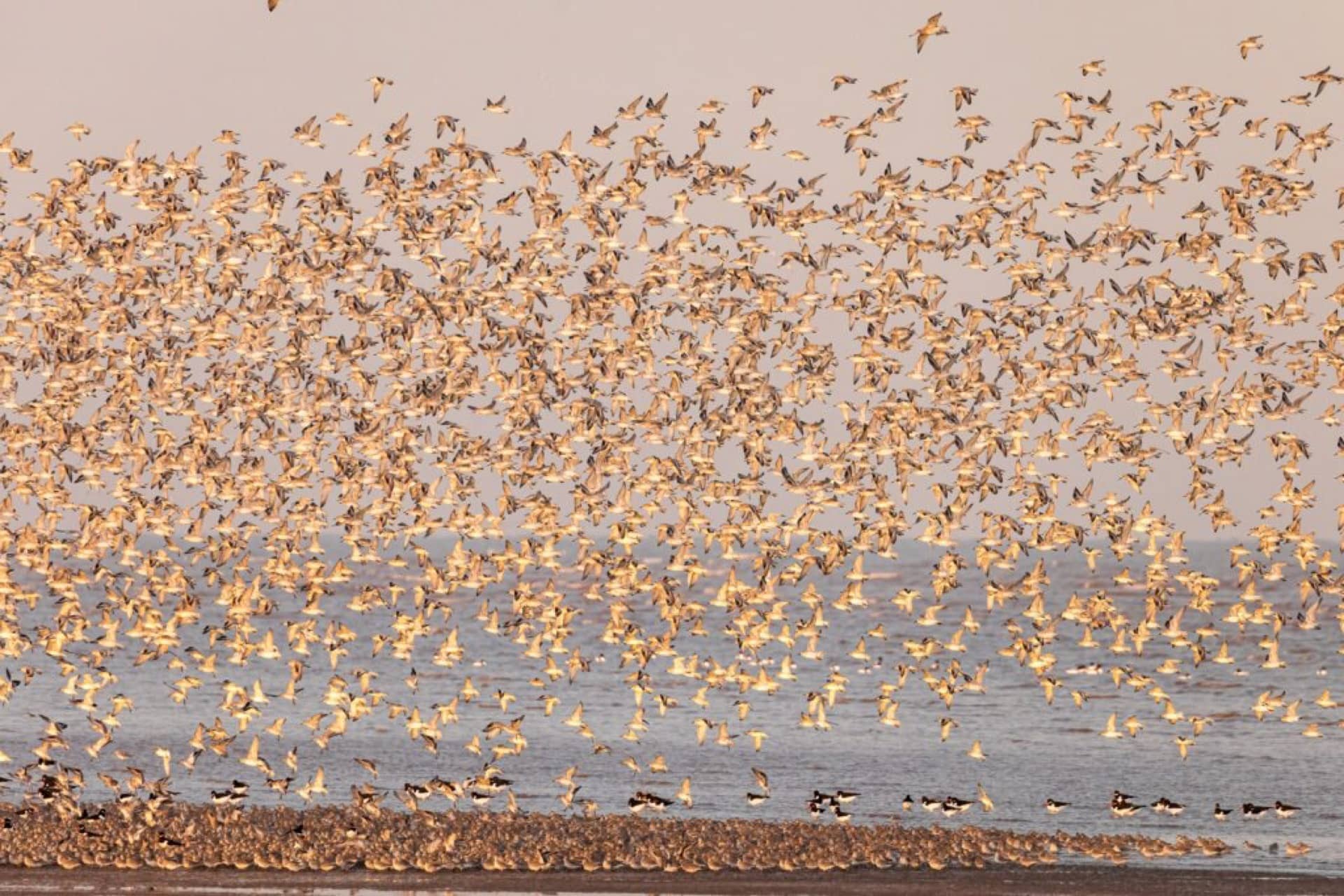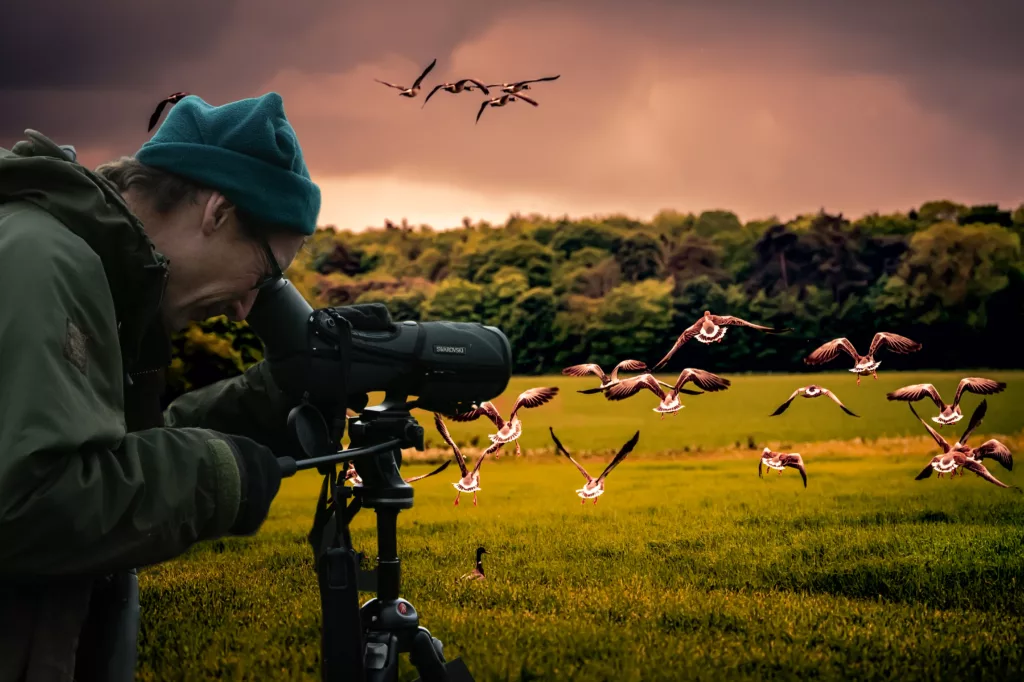
A Storm of Birds
Visit to Snettisham RSPB Nature Reserve – see unique natural spectacle of thousands of birds in flight on the highest tide of the year.
High tide roosts are a natural spectacle that reach their peak on spring high tides. Although the spectacle still happens outside of the highest tide and the geese are consistent during the Autumn and winter months.
At RSPB Snettisham, the highest tides give rise to an astonishing phenomenon. A natural wonder of the world, these epic aerial displays happen just a few times a year and are never the same twice.
This a wild, liminal land of lagoons, tidal mudflats, shingle beach and saltmarsh. Part of the wider Wash, it’s a refuge for many thousands of wildfowl and wading birds including Red Knot, Dunlin, Plovers, Oystercatchers and Bar-tailed Godwits who stalk the mud hunting for shellfish and worms. During the highest tides, known as Spring or King Tides, salt water completely covers the mud. Only then will these thousands of birds take to the air in a fluid symphony of sound and movement. This extraordinary winged ballet is choreographed by instinct, season and weather.
Because Spring Tides are rare, it’s essential to check the date and time before your trip.
If you can’t make a high tide, how about a frosty sunrise? Winter is the season of pink-footed geese, arriving in their thousands from summer breeding grounds in Iceland. Roosting on The Wash mudflats, vast skeins of beating wings fill the skies at first light as they fly inland to feast on sugar beet fields. On icy mornings, it’s tempting to stay tucked up in bed, but witnessing the haunting calls of wild geese at first light is one of life’s most exhilarating and unforgettable experiences. Truly a Norfolk spectacle not to be missed.

Inclusive Coastal Nature at RSPB Titchwell
Norfolk is one of the best places in England for winter birding. Nowhere matches this stunning county for variety of migrating birds, vast numbers of wintering wildfowl and rare sightings. RSPB Titchwell contains most of Norfolk’s magnificent coastal nature in one place, from graceful avocets and majestic marsh harriers to booming bitterns and bearded tits ‘pinging’ from the reeds. Titchwell is accessible if you can’t manage uneven or muddy tracks, wheelchair friendly hard paths take you from open fields to the coastal foreshore via reedbeds, marshes, lagoons and beach.
The haunting cry of geese fills the winter air, echoing across silver skies while the marshes ring with the whistles of wigeon and teal. You might even see elusive otters or busy water voles. It’s a place of constant change, fascinating all year round.
Head through woodland from the car park towards the visitor centre. A steaming coffee will warm you on your way through new worlds of discovery! Follow the boardwalk to explore the marshy woodland carr at the edge of the reedbeds, then head to the main path where reedbeds give way to freshwater lagoons full of sound and movement. Shelter in accessible hides to watch birds dip feeding over the water. Then pass brackish lagoons to tidal mudflats and a sweeping expanse of sand, sea and sky. Listen for the calls of oystercatcher, dunlin, or curlew. Immersed in nature’s wild winter, it feels like you’re on the edge of the world. And then, head back for cake!

Return of the Geese
The sight of pink foot geese taking flight at dawn is one of nature’s most magnificent winter spectacles. But if prising yourself from bed on a frosty morning is just too painful, you can still witness the geese returning to their roosting grounds as the light fades to dusk. Numbers have been increasing over the last 50 years, with upwards of 100,000 now wintering in Norfolk.
During the day the geese are scattered across the Norfolk fields, shy and hard to spot, moving in grey clusters over the muddy land where they grub for sugar beet tops, searching for root crops rich in carbohydrates. But at the end of an autumn or winter afternoon, try waiting on Lady Anne’s Drive at Holkham. Watch the landward horizon, for this is where they’ll appear. Listen for their calls, piercing the leaden sky until a faint V-shaped skein comes into view. Keep your eyes on it until you see a multitude, fluctuating as formations take turns to lead the flocks.
The skies grow loud and shapes become sharper as they close the distance towards you, arriving in waves. The air is alive with noise, a rowdy hubbub of gathering geese. It’s a little like a starling murmuration, except these birds are almost as big as swans. Then they drop onto the marsh, hoards from the Icelandic Highlands plunging in wheeling spirals. They land. And suddenly it’s silent. You’ve witnessed something truly extraordinary. Now…time to find a nice warm pub!
Build your own itinerary
If you fancy creating your own itinerary for a day trip to Norfolk or a longer visit, it couldn’t be simpler. Just go to Search Activities and select from our wide range of free and paid-for experiences, saving any that capture your imagination with the click of a button.
Once you’ve finished, you’ll find all the information stored in My Favourite, where you can drag and drop activities to create your own day-by-day itinerary! You can download this to a calendar and even share it with friends.
